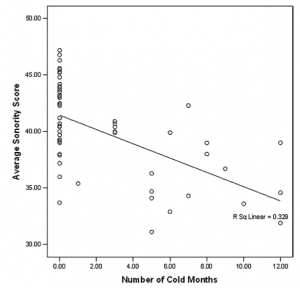![]() Through this post on Sprogmuseet about Atkinson’s analysis of the out of Africa hypothesis, I found an article by Ember & Ember (2007) (who also quantified the link between colour lexicon size and distance from the equator, see my post here) on Sonority and climate. The article extends work by Fought et al. (2004) which finds that a language’s sonority is related to climate. Sonority is a measure of amplitude (loudness) as is greater for vowels than for consonants (for example, see here). Basically, the warmer the climate, the greater the sonority of the phoneme inventory of the population. The theory is that “people in warmer climates generally spend more time outdoors and communicate at a distance more often than people in colder climates”.
Through this post on Sprogmuseet about Atkinson’s analysis of the out of Africa hypothesis, I found an article by Ember & Ember (2007) (who also quantified the link between colour lexicon size and distance from the equator, see my post here) on Sonority and climate. The article extends work by Fought et al. (2004) which finds that a language’s sonority is related to climate. Sonority is a measure of amplitude (loudness) as is greater for vowels than for consonants (for example, see here). Basically, the warmer the climate, the greater the sonority of the phoneme inventory of the population. The theory is that “people in warmer climates generally spend more time outdoors and communicate at a distance more often than people in colder climates”.
Continue reading “Sonority and Sex: Why smaller communities are louder”

